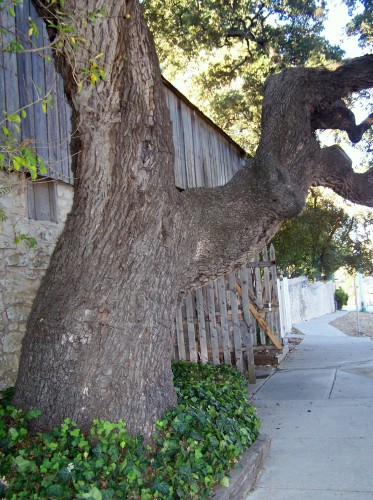Blondie and I hit Sam’s Club last weekend for some holiday oddities and endities, and as we were heading out to the parking lot, Blondie remarked that everyone seemed rather … subdued. I couldn’t really see that the other customers were any more depressed than usual, wheeling around great trollies piled full of case-lots and mass quantities than any other Sunday, as I am still trying to throw the Cold From Hell now in it’s third week of making me sound as if I am about to hack up half a lung. But that is just me good thing I work at home, the commute is a short stagger to my desk, where I do the absolute minimum necessary for the current project, and another stagger back to to bed, take some Tylenol, suck on a cough drop and go back to sleep for several hours. The cats like this program, by the way a warm human to curl up close to, on these faintly chill December days.
 Sgt. Mom
Sgt. Mom
History Friday – The Pilgrim Road
We took a road trip, my daughter and I, in the summer of 1990. We lived then on the northern outskirts of Zaragoza, in an urbanization by the main road towards Logrono, so one summer day we packed the tent and our sleeping bags, and a little gas camp stove in the trunk of the Very Elderly Volvo, and went north, along the long, red-clay valley of the Ebro, where is grown the finest red wine in Spain, north and away from the ancient city of the Pilar, where the Virgin Mary appeared to St. James in the forum that the Romans built, and the shops along the ancient cardo now called the Calle Alfonso sell dark chocolate-dipped dried fruits, and the wind blows the trees into gnarled shapes bending to the south.
See the Violence Inherent in the System!
So it is not like violence by union members in Michigan against pro-right-to-work activists came as any big surprise to me … or should have to any other sentient being. I mean, this comes after a couple of years of incidents involving members of the SEIU better known as the Purple People Beaters and Tea Party protesters going at it. Not that our gutless establishment press organs ever seemed to take notice … or as little notice as they can and still retain a few lingering shreds of credibility, while they remain prostrate and adoring the mighty figure of Ozymandius … sorry, Obama. And in pop-culture circles, historically unions seem to enjoy at least a token respect, for which I hold Hollywood responsible. Why the entertainment industry adores unions, as they are full of plucky, honest blue-collar laboring types, and if it weren’t for unions, why we would be working seven days a week, up to our knees in toxic sludge, owing our soul to the company store, and breaking rocks in the hot sun … oops, sorry, flashback there to about a million Phil Ochs pseudo-folk songs.
Archive – Oh!! Christmas Tree!
(From the old SSDB archive – a reminiscence about the search for the perfect Christmas tree, December, 1981.)
It really takes a gift to find yourself on a soggy-wet mountainside in on a Sunday afternoon in December, with a fine drizzle coagulating out of the fog in the higher altitudes, slipping and sliding on a muddy deer track with a tree saw in one hand, and leading a sniffling and wet (inside and out) toddler with the other.
Yep, it’s a gift all right, born of spontaneous optimism and an assumption based on the map on the back page of the Sacra-Tomato bloody-f#$*%^g Bee newspaper, and a promise to Mom. Said map made the %$#*ing Christmas tree farm look like it was a couple of blocks, a mere hop-skip-and-jump from the back gate of Mather AFB’s housing area, an easy jaunt on a pleasant Sunday afternoon, a lovely and traditional Christmas pastime, choosing your own tree from the place they were growing in!
History Friday – A Deep-Dyed Villain

He really wore a black hat, this particular villain; he was known and recognized throughout the district around Fredericksburg and the German settlements in Gillespie County by his fine, black beaver hat. Which was not furry, as people might tend to picture immediately but made of felt, felt manufactured from the hair scraped from beaver pelts. This had been the fashion early in the 19th century, and made a fortune for those who sent trappers and mountain-men into the far, far west, hunting and trapping beaver. The fashion changed and the far-west fur trade collapsed, but I imagine that fine hats were still made from beaver felt. And J.P. Waldrip was so well-known by his hat that he was buried with it.